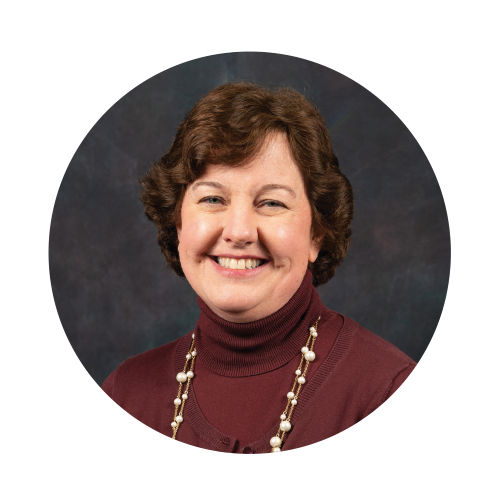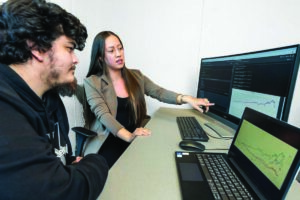Early on, Patricia Morreale, Ph.D., knew she was drawn to a career in science or engineering. With an early exposure to problem-solving through math, science, and the hands-on experience of taking things apart, her interest in these subjects continued to grow. Later during college, her exposure to computer science set her on a path to becoming a leader in the field, a journey that would take her from a curious student to Professor and Chair, Department of Computer Science and Technology, Hennings College of Science, Mathematics, and Technology, at Kean University.
Unlocking Opportunities through Computer Science
During a university summer program following her junior year of high school, Morreale had the chance to explore a programming language and how to apply it to solve problems. “I was fascinated by the idea that I could instruct machines to perform tasks, and this sparked a new interest in programming and engineering,” shares Morreale. “I realized that computer science was at the core of nearly every engineering field, and I liked the idea of being involved in something so fundamental to technology. At the time, I wasn’t sure what specific career I wanted, but I knew I wanted something versatile and portable. Computer science, with its broad applications and adaptability, stood out as the perfect choice.”
As she often tells her students, the beauty of computer science lies in its portability. “You can get off a plane anywhere and they’re going to need you,” says Morreale. “Whether working remotely or joining a local firm, computer science skills are in constant demand. Unlike professions that require specific licensing, computer science offers flexibility and relevance in today’s world. In fact, with the increasing reliance on technology in everyday life, understanding how computers work has become an essential skill for managing the modern world.”
After receiving her B.S. in computer science from Northwestern University, Morreale worked in the industry for several years in network design where she helped build large-distributed networks that went from coast to coast. “During this time, I returned to graduate school in hopes of opening doors to new opportunities,” shares Morreale. “I wanted more control over the work I was doing and the ability to pursue my own interests, so I took a year off to complete my Ph.D. residency, eventually transitioning into academia with positions at Northeastern Illinois University, and later, Stevens Institute of Technology. Having credentials that are portable allows me the flexibility to explore different opportunities and meet the needs of an ever-changing industry.”
In her transition from industry to academia, Morreale says having colleagues who have also worked in the industry provides a shared understanding of organizational goals, time management, and return on investment that enhances their ability to lead effectively. “My industry experience has been crucial in managing people who are results-driven and focused on efficiency. I’m able to speak to corporate partners, write proposals, and apply a big picture perspective to smaller tasks. We also have a commitment to student success that parallels the industry mindset—viewing students as valuable assets to our department and whose development is key to their broader impact in the world.”
Promoting Interdisciplinary Conversations
Making significant contributions through her research in machine learning and network systems, Morreale has helped drive innovations in error detection and secure processing, which have been patented and brought to market. “My earlier work in network systems and machine learning is a result of partnering with a colleague at Argonne National Laboratories and our interest in detecting degradation in a network environment,” explains Morreale. “By detecting early signs of degradation, we could intervene before a complete collapse or failure occurred, sampling and testing indicators to address issues proactively rather than waiting for a hard failure.”
“These solutions resulted from collaboration and casual conversations among researchers and showed the importance of regularly discussing topics, whether via email, at conferences, or in the hallway,” continues Morreale. “Cross-pollination and interdisciplinary conversation is highly important to overcoming challenges and finding impactful solutions. Talking to different people who all bring unique experiences and perspectives helps generate innovative ideas and leads to breakthroughs that wouldn’t be possible in isolation. So many different fields are impacting computer science—whether it’s artificial intelligence (AI) being used for biological discovery and new drug development or computational methods applied to large and ambitious problems. By working across disciplines, we not only solve technical problems but also address real-world challenges with solutions that are more comprehensive, effective, and far-reaching.”
“I’ve learned many wonderful techniques from NCWIT to encourage students to consider technology careers and find computing experiences that align with their interests. This organization also led me to work with the Computing Alliance of Hispanic-Serving Institutions (CAHSI), which is more than eighty colleges and universities in the United States working together to recruit, retain, and advance students in computing. Working collectively with other institutions who want to empower all students has been very beneficial and has created a larger research and education community.”
— Patricia Morreale, Ph.D.
Professor and Chair, Department of Computer Science and Technology, Hennings College of Science, Mathematics, and Technology,
Kean University

Instilling Computational Thinking
Along with facilitating interdisciplinary collaboration, Morreale is dedicated to expanding participation in computer science by promoting faculty development and encouraging undergraduate students to engage in research opportunities. “I encourage my students from all backgrounds to see themselves as part of the tech world,” says Morreale. “Through outreach programs and campus tours, we create an inclusive environment at Kean where students are reminded, ‘You can be here.’ Whether through K-12 initiatives or conversations with prospective students, I want to make sure they recognize that everyone, has a place in computing and that this discipline is fundamental to our day-to-day lives. We aim to flatten access to technology and demonstrate that with the right support, anyone can reach their goals.”
To help improve student success, Morreale says we need to reach students earlier in their education. “As technology and knowledge evolve, many of the topics that were once reserved for graduate courses—such as artificial intelligence, machine learning, and data visualization—are now part of undergraduate and high school curricula. This shift reflects the fact that K-12 students are entering college with a stronger foundation in areas like cybersecurity and the basics of AI, including skills like shaping search criteria and using tools like ChatGPT. These tools are advancing rapidly, and academic institutions need to be prepared to meet students where they are in their understanding.”
“Looking back about ten to fifteen years ago, there was a focus on instilling computational thinking in K-12 students—teaching them to think sequentially, with an understanding of what comes first, second, and third to solve a problem,” continues Morreale. “Today, many students are already coming to college equipped with this kind of thinking, showing that early exposure to computational concepts is paying off. To continue improving student success, it’s crucial to build on this foundation and ensure that higher education institutions are ready to challenge and support these students as they advance in their knowledge of technology and its applications.”
To promote AI and advanced technology education earlier, Kean is making professional development a priority to help faculty be well-equipped to mentor incoming students. “The research topics that today’s undergraduates are ready to take on are even more advanced, so we must ensure we have a sophisticated faculty mentoring program to help our new student researchers build their own ideas, work collaboratively, understand constructive criticism, and manage a project from start to finish.”
As a member of the Council of Undergraduate Research (CUR), Kean is able to access valuable resources and networking opportunities that help support undergraduate research and strengthen the institution’s research presence. “To cultivate the next generation of scientists and researchers, we must invest in undergraduate students, providing them with opportunities to engage in research and develop their skills early on,” says Morreale. “In working with CUR, we can identify and mentor young talent, empowering them to create research posters, write papers, and pursue advanced degrees. I’ve been very fortunate to have had many great students who have gone on to amazing careers, continued to graduate school or became teachers who are now shaping the next generation of students.”
Morreale is involved with the NCWIT, which aims to increase participation in the field of computing. “I’ve learned many wonderful techniques from NCWIT to encourage students to consider technology careers and find computing experiences that align with their interests,” shares Morreale. “This organization also led me to work with the Computing Alliance of Hispanic-Serving Institutions (CAHSI), which is more than eighty colleges and universities in the United States working together to recruit, retain, and advance students in computing. Working collectively with other institutions who want to empower all students has been very beneficial and has created a larger research and education community.”
“Edge fosters a community of scholars and professionals who exchange ideas and collaborate, which is essential for driving impactful research and innovative solutions. This community-building is vital in creating partnerships that can lead to significant advancements. Looking at the history of New Jersey, the state has always thrived on strong partnerships between universities, researchers, and industry leaders, joining together to tackle large-scale challenges. New Jersey’s geographical and cultural diversity further enriches this environment and makes it an ideal place for impactful collaborations to flourish.”
— Patricia Morreale, Ph.D.
Professor and Chair, Department of Computer Science and Technology, Hennings College of Science, Mathematics, and Technology,
Kean University
Supporting Local Workforce Development
To help retain graduates within the state, many institutions are focusing on developing strategies that aim to keep skills within the local workforce rather than seeing professionals take their talents elsewhere. “New Jersey has an outstanding community college and higher education system,” says Morreale. “We want to make sure there are plenty of opportunities for our students within our region to excel in the workforce. The New Jersey AI Hub provides a remarkable opportunity for collaboration between industry and university, and I think our state can lead the nation in supporting workforce development and advancing research and innovation.”
Building a strong support system is essential for engaging students in meaningful research opportunities, significantly enhancing their academic experience and contributing to a positive career trajectory. “We want to demystify the traditional idea of what a research career looks like and show students that research can take many forms and offer diverse career paths in various fields,” explains Morreale. “We begin by introducing topics of interest and research in our classes and encouraging students to meet with us outside of class. Faculty members also inform students about academic careers and the rewards they can offer, which has proven helpful. For example, when a conference paper is accepted, the excitement of presenting it at a prestigious conference, sometimes in fascinating locations, can be a thrilling experience for students.”
Morreale adds, “We also highlight the various rewards academic work can bring, such as having your name published or securing research funding. Many careers lack direct feedback, making it difficult to know if your contributions are making a significant impact. In academia, however, there’s more immediate recognition—students can see the results of their work, whether through published papers or funded grants. I want to make sure I emphasize these successes and explain the process behind them. Kean also provides summer support for faculty-student researcher teams that helps develop critical skills, foster innovation, and provide valuable hands-on experience in collaborative environments.”
Expanding Advanced Technology Education
Kean University is advancing its educational offerings with the introduction of two innovative programs—a Ph.D. in Computer Science and a Bachelor of Science in Artificial Intelligence. These programs aim to solidify Kean’s role as a leader in technological education, catering to the growing needs of both local and global industries. The Kean Board of Trustees approved both programs in December 2024 and they are now in review by the New Jersey President’s Council Academic Issues Committee, with the potential for the AI program to accept students as early as Fall 2025 and the Ph.D. program to follow soon after.
The proposed Ph.D. in Computer Science will focus on key areas such as artificial intelligence, cybersecurity, and data science, aimed at developing the next generation of technology leaders for careers in research, academia, and industry. Similarly, the Bachelor of Science in Artificial Intelligence program will launch with an initial cohort of 25 students, providing graduates with the expertise needed to succeed in the rapidly expanding global AI sector, which is expected to grow to $407 billion by 2027. This program aligns with New Jersey’s efforts to promote AI innovation, investment, and development within the state.
“Institutions like Kean can play a significant role in ensuring that all students are equipped with these crucial ethical skills and determining ways AI can be incorporated into general education. In a landscape where numerous AI tools compete for attention, the goal is to guide students forward responsibly, ensuring they not only keep pace with technological advances but also use them in an ethically sound and meaningful manner.”
“As technology and knowledge evolve, many of the topics that were once reserved for graduate courses—such as artificial intelligence, machine learning, and data visualization—are now part of undergraduate and high school curricula. This shift reflects the fact that K-12 students are entering college with a stronger foundation in areas like cybersecurity and the basics of AI, including skills like shaping search criteria and using tools like ChatGPT. These tools are advancing rapidly, and academic institutions need to be prepared to meet students where they are in their understanding.”
— Patricia Morreale, Ph.D.
Professor and Chair, Department of Computer Science and Technology, Hennings College of Science, Mathematics, and Technology,
Kean University
In looking toward the future, computing is becoming more responsive to individuals with advancements in AI, personalized systems, and adaptive technologies that cater to users’ unique preferences and requirements. “As computing becomes increasingly tailored to the individual, it opens up new opportunities for innovation, accessibility, and solutions that can significantly improve everyday life and work,” says Morreale. “Computer science and education research play a crucial role in how people learn, especially since many courses are delivered online or have a digital component,” continues Morreale. “As the pedagogical process evolves, it’s important to examine and integrate areas such as ethics. We have an ongoing project in collaboration with other U.S. schools, funded by the National Science Foundation (NSF) and CAHSI, where ethics modules are being incorporated into computer science courses. I’m working with an ethicist from Kean’s Department of History, and we aim to provide students with the tools to examine AI-generated results critically, understand when AI might “hallucinate,” and determine when it is appropriate—or inappropriate—to use AI technologies.”

While ethics is already part of the curriculum, Morreale emphasizes the need for a deeper focus on how students engage with AI and cite these tools properly. “Institutions like Kean can play a significant role in ensuring that all students are equipped with these crucial ethical skills and determining ways AI can be incorporated into general education. In a landscape where numerous AI tools compete for attention, the goal is to guide students forward responsibly, ensuring they not only keep pace with technological advances but also use them in an ethically sound and meaningful manner.”
Fostering a Supportive Research Community
Edge is dedicated to supporting academic leaders and experts in their mission to drive innovative research and foster transformative initiatives, particularly in the fields of computer science and education. “At Edge, we are committed to supporting academic leaders and experts like Dr. Patricia Morreale in their efforts to advance innovative research, equitable education, and transformative initiatives in computer science,” says Dr. Forough Ghahramani, Assistant Vice President for Research, Innovation, and Sponsored Programs, Edge. “Her leadership in human-centered computing, responsible AI, and broadening diversity in the field exemplifies the kind of impactful work that drives progress and creates opportunities for future generations.”
“Cross-pollination and interdisciplinary conversation is highly important to overcoming challenges and finding impactful solutions. Talking to different people who all bring unique experiences and perspectives helps generate innovative ideas and leads to breakthroughs that wouldn’t be possible in isolation. So many different fields are impacting computer science—whether it’s artificial intelligence (AI) being used for biological discovery and new drug development or computational methods applied to large and ambitious problems. By working across disciplines, we not only solve technical problems but also address real-world challenges with solutions that are more comprehensive, effective, and far-reaching.”
— Patricia Morreale, Ph.D.
Professor and Chair, Department of Computer Science and Technology, Hennings College of Science, Mathematics, and Technology,
Kean University
In exploring ways to enhance the research and educational capabilities of institutions like Kean, Morreale says partnerships with organizations like Edge help ensure that all participants have access to the necessary computing resources to advance their work. “Through collaboration opportunities, advanced networks, and grant assistance, Edge helps address the challenges that arise when individuals lack reliable internet access or are hesitant to trust digital technologies. These issues are central to promoting an equitable environment where everyone can engage confidently with technology, regardless of background or resources.”
“Edge fosters a community of scholars and professionals who exchange ideas and collaborate, which is essential for driving impactful research and innovative solutions,” continues Morreale. “This community-building is vital in creating partnerships that can lead to significant advancements. Looking at the history of New Jersey, the state has always thrived on strong partnerships between universities, researchers, and industry leaders, joining together to tackle large-scale challenges. New Jersey’s geographical and cultural diversity further enriches this environment and makes it an ideal place for impactful collaborations to flourish.”



